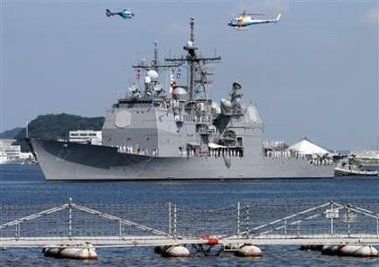U.S.Missile Defense Ship Arrives In Japan
The USS Shiloh (CG-67), the first missile-defense capable ship to be deployed in Japan, arrived in the port of Yokosuka eight weeks after North Korea unnerved the region with a barrage of missile tests. he deployment of the Shiloh, boasting Standard Missile-3 interceptors for shooting down medium-range ballistic missiles, is a highly symbolic first step in a joint U.S.-Japanese program to try to shield Japan and the region from any a missile attack. The two allies stressed the significance of the ship's arrival as an example of the importance the United States attaches to its security alliance with Japan, although the chances of preventing a missile attack on the country with a single vessel are slim. U.S. and Japanese officials welcomed the 10,000-tonne cruiser and its 360 crew at a colorful ceremony that included a Japanese-style taiko drum performance by U.S. sailors.
The USS Shiloh (CG-67), the first missile-defence capable ship to be deployed to Japan, arrives in the port of the U.S. naval base in Yokosuka, south of Tokyo. "The United States remains committed to the defense of Japan and peace and stability in the western Pacific,," U.S. Navy Secretary Donald Winter said at the ceremony. In July, Pyongyang test-fired a series of ballistic missiles, an incident that drew attention to Japan's lack of defense systems eight years after Tokyo was spooked by a previous North Korean ballistic missile test in 1998. Many analysts, however, have cast doubt on whether missile defense systems can reliably shoot down incoming missiles, and they criticize the program for drawing funds away from other areas of defense spending. Missile defense accounts for 140 billion yen ($1.2 billion) of Japan's 4.81 trillion yen ($41 billion) defense budget this year. The defense agency plans to seek a record 219 billion yen for missile defense in the fiscal year from next April 1, Kyodo news agency reported, although such requests are usually whittled down in the budget process. As a second line of defense, the U.S. military will begin to install Patriot Advanced Capability-3 (PAC-3) interceptors at its Kadena Air Base on the southern Japanese island of Okinawa in September and plans to make them partly operational by the end of the year. The ship-to-air SM-3 interceptors are designed to shoot down ballistic missiles in mid-flight, when they fly outside the earth's atmosphere, while ground-based PAC-3 interceptors target missiles in their terminal phase, shortly before they reach their targets. Japan also plans to install its own missile defense hardware, including fitting its four Aegis radar system-equipped warships with SM-3s, but the first of these ships will not be ready until sometime in the financial year that starts next April. Kyodo news agency said the United States had offered to provide Japan with up to 80 more Patriot missiles, as Japan seeks to speed up its own deployment of ground-based interceptor missiles.




















<< Home